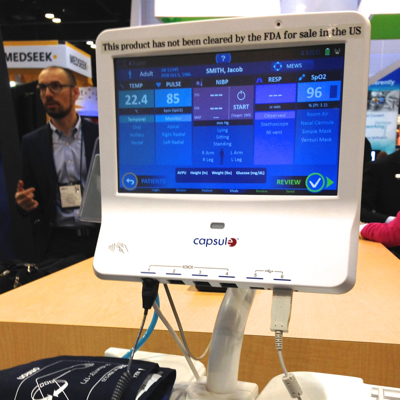Yours truly was quoted in an article in FDC Reports' newsletter The Gray Sheet (subscription only) last week about connectivity. The story was inspired by a comment from Bill Crounse, the director of Worldwide Health at Microsoft, during the World Healthcare Innovation and Technology Congress held in Washington, D.C., earlier this month. He said, ""I no longer believe that technology is really the issue that prevents us from getting things done. We have the technology ... We've cracked the code on things like mobility and wireless devices and broadband. The remaining barriers are really all-around barriers to adoption."
The story provides an overview of connectivity in both acute care and remote monitoring, from both vendor and customer perspectives. The story closes with this observation:
"The medical device companies are becoming chimeras, where they're part IT company, and they're part embedded system company," Gee noted. But, as long as their mindset remains that of an embedded system company trying to protect the "black box" of proprietary system design, it will be difficult to move forward, he said.
Jason Williams expresses a similar lament about the lack of connectivity in a great post on NeoTool's blog titled, Bridging the Device Divide. In a comment to the post, standards guru Todd Cooper observes:
Bottom line is that medical device vendors make more money with either proprietary connectivity or strategic partnerships, and end users - provider orgs - do not demand open standards-based connectivity. It is often called out in RFPs - but gets dropped in the decision making process. K-P [Kaiser Permanente] is one of the few org's drawing a line in the sand on PnP med dev connectivity. "Collaborative partnerships" are the status quo and have been the basis of controlling and limiting device connectivity both at the PoC and to the enterprise.
Todd's referring to Kaiser's new purchase contract language that specifies medical device vendor responsibilities for supporting connectivity. You can read an except of the contract language in this post. Rumor has it that Philips has recently declined to meet some of those requirements; it will be interesting see if Kaiser sticks to their guns and drops Philips as their patient monitoring vendor going forward.
In Jason's blog post he quotes Robert Nadler who says, "...our business is building medical devices, not EMR solutions." I don't think medical device vendors will have the luxury of maintaining that point of view for much longer. I spoke with David Freeman and Munesh Makhija of GE Healthcare's patient monitoring group a few weeks ago. They attended the CMEF and saw an exhibit floor filled with vendors who are doing the same color displays with waveforms that GE is doing - at 30% lower cost. Rather than playing the manufacturing cost game, GE is looking to software to add clinical value and differentiate from low price competitors. Philips seems to be taking a similar approach with their acquisitions of Emergin and VisICU.
The days of staying in that nice familiar embedded device comfort zone are limited. This has always been the case as connectivity transforms medical device product categories. Remember E for M? They were once the market leader in cath lab recorders. They too decided they didn't want to do software. They contrast nicely with Marquette Electronics who saw connectivity as an opportunity and redefined the product category - driving E for M out of business and capturing a major share of the cath lab market. (Another great example of leveraging connectivity is Alaris.)
You can access both Jason's and Bob's excellent blogs from the Blog Roll in the right hand column of this web page.



Recent Comments